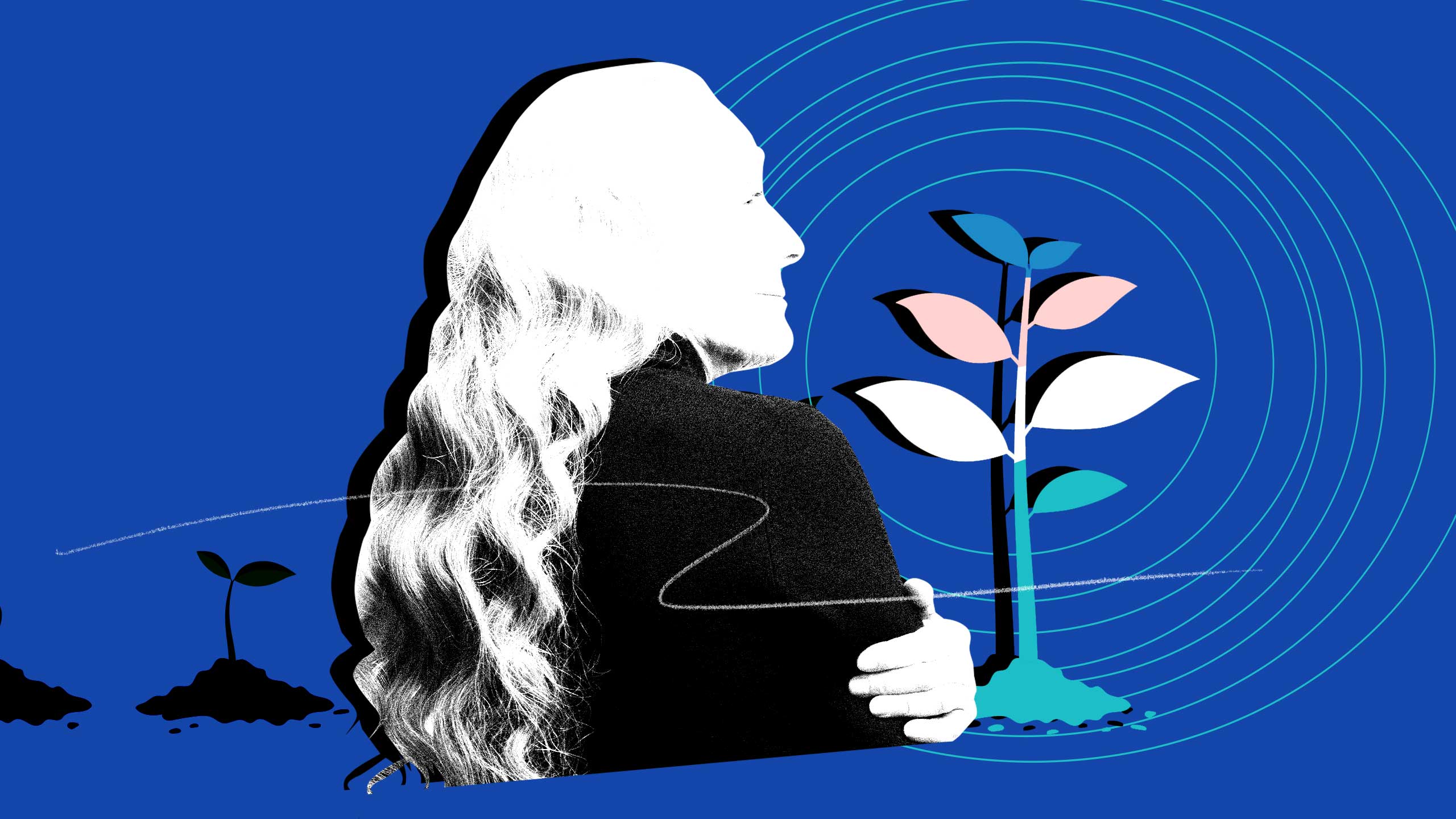When I came out to my husband in June 2020, on the night of my 38th birthday, I felt like the oldest trans person alive. I had every reason to know this wasn’t true: I’d been socializing and working with trans people since at least the early 2000s. I could (and often did) Google “late in life transition” and saw women in their 60s and 70s, posing with wives and children. None of that changed my feeling that I had suddenly become some sort of a middle-aged Steve Buscemi, toting my skateboard down the hallway, ready to greet my fellow kids.
Trans culture was youth culture and youth culture was trans culture; every time I went to a queer meetup full of college students or saw someone tweet about their “late transition” at age 25, I felt that I had aged from egg to elder in an instant, like a thousand-year-old mummy being exposed to sunlight and crumbling to dust.
This was, granted, a dramatic way of seeing things. It was also fairly insulting to all the people older than I am (which, again, is a lot of folks). Still, it’s not an uncommon experience. “There’s this huge swath of time between the ages of 25ish and 55ish where there’s not a lot of easily organized community stuff [for trans people],” says Robin Sweeney, a gender therapist. “I think we lose a lot of organizing knowledge and community support.”
The conflation of “trans” and “young” isn’t just lonely—it also serves the purposes of the dominant culture. Organized transphobes in the U.K. and U.S. have done immeasurable damage by portraying trans existence as a dangerous youth fad, the “craze seducing our daughters” or the edgy “lifestyle choice” adopted by rainbow-haired, pronoun pin-wearing college activists. The erasure of elders also promotes the lie that being trans is a tragedy: if you don’t see trans people aging, it’s easy to assume that none of us live long enough to get old.
Trans youth have their own inherent dignity, of course, and no one can take it from them. They also have faster metabolisms, better skin and the ability to drink more than two beers without feeling like they’re about to die. Still, it is important for us to see trans grownups (and not only for the sake of my own middle-aged ego). Until we can see the full range of trans adulthood, we will be people without a future—or a past.
Queer history post-Stonewall comprises just over 50 years; short enough to fit within one living person’s memory. It’s customary to point out that we are missing huge chunks of that collective memory due to the AIDS epidemic, which decimated a generation. Nonetheless, there are trans people living and working today who remember it all.
Roz Kaveney is a Lambda Literary Award-winning novelist, poet and cultural commentator who, at 72, has seemingly been everywhere and met everyone; in the course of an hour-long conversation, she mentions Rachel Pollack, Kathy Acker, Kate Bornstein and just about every other famous trans or queer person who was out before 2002.
“Out” is a key qualifier. Kaveney notes that when she transitioned, in the mid-1970s, the vast majority of trans women were prohibited from being public about their transition due to the medical gatekeeping of the time, which saw “passing” as the only acceptable goal.
“An awful lot of my generation went stealth,” Kaveney says. “I was extremely lucky in being able to get myself sent to a shrink who didn’t try and force it on me. I argued, purely practically, that given that I’m not invisible, that I’ve always been quite loud, that I write, that I went to Oxford and was very far from invisible as an undergraduate, and I’m six foot four, stealth really wasn’t an option.”
If Kaveney hadn’t been able to convince that shrink, her body of work would have been lost to us. “If I was going to have the sort of career I wanted, it made no sense. I wouldn’t be able to do any of the things I wanted to do and still transition if I went stealth.”
“If you want to know where the older trans people are, the answer is that they’re all around you; they’ve just been told never to speak up.”
Much trans history has been structured by that contradiction: in order to transition, you could not make being trans part of your identity. Trans people were all but forbidden to engage in activism—it’s hard to organize around your oppression when you are never allowed to bring it up—and the lack of trans activism made coming out more dangerous. In other words: if you want to know where the older trans people are, the answer is that they’re all around you; they’ve just been told never to speak up.
More of those people are out today, due to the shifting generational attitudes and wider acceptance of trans people. That includes trans women like Renate, a woman in her 80s living in upstate New York, who began living “full-time” in her 70s after years of being closeted or semi-closeted. (Her last name has been withheld for safety reasons.)
“You’ve got to present yourself in ways that get you included with most people,” she tells me over the phone. “And if you find that they aren’t going to play the game, walk away, because all you’re going to do is get hurt.”
Renate’s statement speaks to a critical divide: whereas trans millennials and Zoomers often operate in a social context where being visibly trans and unassimilably, unpalatably queer-as-in-fuck-you is a point of pride, older trans people (or, at least, those I spoke to for this piece) are often ambivalent and cautious about standing out. That attitude can produce some intergenerational friction, as Renate readily admits, but it comes from a specific history, one in which receiving even basic respect or dignity as a trans person often felt impossible.
“The whole game has changed,” Renate says. “I knew people who didn’t want to come out. They were scared to death, and you couldn’t talk about it. When you went out to a public place, if there was a bunch of you together, they would either try to shoo you out or put you upstairs by yourselves. That doesn’t happen anymore.”
Nowadays, we can practice trans politics, or aspire to get “beyond” identity politics altogether, but that’s because the work of establishing trans identity has been done. I knew trans people existed by at least 1999, when the notoriously grisly Brandon Teena biopic Boys Don’t Cry came out on video; the depictions of that era were limited and stereotypical, to the extent that I had trouble seeing myself in them, but I always knew that gender transition was something real that people actually did, and not just some bizarre daydream I had come up with on my own. The elders I spoke to had pieced themselves together from nearly nothing: Kaveney found trans porn stocked near the sci-fi magazines she loved. Renate was studying anthropology and found references to gender fluidity in shamans.
“The first time I actually saw a transsexual—that was what we said back then—I was a corrections officer, and I was working in a maximum security prison in New York state,” says Teri Wilhelm, a New York-based woman who transitioned in her 50s, in the late 2000s, after decades of being privately out to herself. “I was walking past a cell and here’s a woman in the cell—a beaten, a literally beaten person… [she] couldn’t speak English, and really struggled, and you could see the struggles in the prison made the life that she probably had to live on the street look easy. That was my first meeting with a trans person, and I was supposed to think that was me. I really didn’t want to think that.”
Wilhelm is now on the board of Equality New York, where she’s working to advocate for humane treatment for incarcerated trans people. Of all the stories I heard reporting this piece, hers stuck with me longest. I keep thinking about that moment of shocked recognition, in which one woman saw another for the first time, and about what it takes to admit to yourself that you have more in common with the beaten woman in the cell than you do with the colleagues who put her there.
Some people spend their whole lives running away from that kind of realization; some people step forward. That work of closing the gap between self and Other is at the centre of so much queer activism. I wonder what we miss, by not hearing those early stories, about what it took to step forward when the whole idea of us felt new.
The medical emphasis on “passing” has an ugly legacy. At least one woman I spoke to mentioned that, when she first considered transitioning, doctors would not provide hormones or surgery to patients past a certain age. They believed that those who transitioned after their early 20s—particularly trans women—lost the ability to blend in.
That myth dogs adult transitioners to this day. Nearly everyone I spoke to mentioned it. Even the best-intentioned talking points put people off. “When I was considering testosterone a bunch of laws were in process to stop trans kids accessing transition care and there was a bunch of discourse about how if you don’t transition before puberty, you won’t get the best results,” says Shepherd (last name withheld), a trans man who transitioned at 43. “I ended up asking a trans masculine friend who started T in their late 20s if I should even bother.”
For what it’s worth, the myth isn’t true: again, Renate didn’t live full-time as a woman until after her 70th birthday, and she told me stories about situations in which she’d passed. More importantly, though, looking cis is only important because of transphobia. In a world where all things were equal, looking trans (which I do) wouldn’t carry any more risk or stigma than “looking Italian”—a physical type, sure, but not a flaw.
Ageism in queer communities, like ageism everywhere else, is bound up in restrictive and backwards ideas about whose body is worth looking at or worth having. The body that is most worth having, though, is the one that you’re happy in—and for many of us, that’s only possible after transition.
The adult transitioners I spoke to typically didn’t transition with the goal of turning into Teddy Quinlivan or Chris Mosier. They transitioned in order to be comfortable, and for practical reasons like not wanting to be sorted in with the wrong gender when they went to a hospital or (eventually) a senior care facility. What is more, many found that there were advantages in not looking like the trans person most cis people expect. New York Times bestselling comic writer (and friend of mine) Lilah Sturges, who is based in Texas, calls it “mom privilege.”
“Ageism in queer communities, like ageism everywhere else, is bound up in restrictive and backwards ideas about whose body is worth looking at or worth having.”
“When I go to the bathroom at Starbucks, or Macy’s, I have this cloak of respectability that I wear because I just look like a middle-aged white lady,” Sturges says. “No one really gives me a second look… even if I look different, even if I’m a little too tall, anything that might mark me as visibly trans, all those other things sort of gloss over it. So that’s a privilege that I carry with me in addition to all the other axes of privilege that I have.”
Which is all to say: the unfair (and, frankly, sexist) idea behind “passing” and age restrictions is that there is no sense in living as a woman unless you can be a young woman in her 20s who your doctor might want to date. But there are many ways to pass, and in this society, for better or worse, there are few people more invisible than a middle-aged woman doing her shopping.
Looking like a nice white lady absolutely isn’t an option for everyone—again, as Sturges notes, white privilege is a load-bearing structure here—but it does have its uses. Renate told me that while she was petitioning Republicans in the Albany county legislature for trans-inclusive policies,she made a point of ending every speech with “Can you please tell me what’s so scary about this grandma?” The Republicans voted yes.
Young people attract media attention because they’re easier to sexualize; no one is making a version of Euphoria about a 40-year-old who has half an edible and watches Wheel of Time with his husband after putting the kid to bed. (Though they should; he sounds hot.) However, young people are also easier to trivialize. It’s easy to say that a five-year-old is too young to know their own mind, that a 12-year-old is succumbing to peer pressure, that a 20-year-old is living through their wild years and will settle down eventually. It’s a lot harder to write off a nice old lady who is looking you in the eye and telling you that she needs to use the fucking bathroom.
Age carries authority, and that may be why we don’t like to see it in trans people. Every trans elder is proof that being trans includes a future; trans existence is viable, it is livable, it is not reducible to any narrow set of stereotypes, and it is a way of being which accrues age and dignity.
Including trans elders in the conversation puts us in touch with history, yes, but more importantly, it shows us the future. All of us will, hopefully, grow old. We will inherit the job of proving that the future is possible. It’s only right to look forward, down the road; to try and see who we might become.


 Why you can trust Xtra
Why you can trust Xtra


